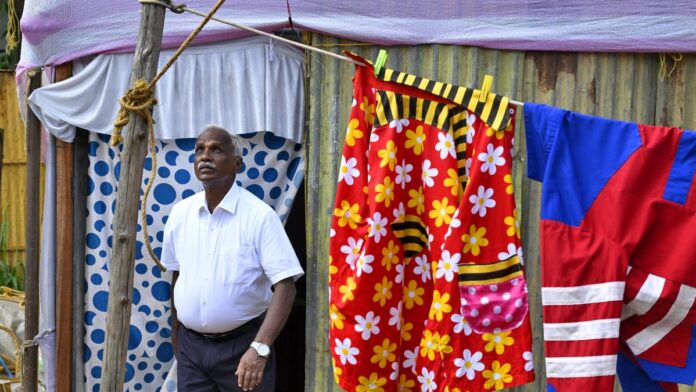Lakshmanan was in third grade when his parents took him to see a circus for the first time in the mid-1950s. He went to catch the Great Eastern Circus in his hometown Thalassery, in Kannur district, famed as the City of Three Cs – cake, cricket and circus. One of the memories that is still fresh in his mind as he witnessed that spectacle is the sight of a young woman who was twirled and lifted by an elephant with its trunk, in a show of strength and skill as a packed crowd cheered.
Today, as Lakshmanan stands tall in the circus ring as a trainer at Gemini Circus, boasting decades of experience in and around the country, he is accompanied by neither the beast nor the cheer.
Lakshmanan talks about his experience before the show at Gemini Circus on show at Thiruvananthapuram.
| Photo Credit:
NIRMAL HARINDRAN
“The circus is in a decline, and I don’t think we might be able to sustain it for more than two years,” says 77-year-old Chakiyath Lakshmanan, who has been working in the industry for 65 years.
Established in 1951, Gemini Circus founded by MV Shankaran and K Sahadevan, had its maiden performance on August 15, in Bilimora, Gujarat. This iconic establishment entertained guests of honour such as the former prime ministers Jawaharlal Nehru, Indira Gandhi and Rajiv Gandhi, American civil rights activist Martin Luther King Jr., Russia’s Valentina Tereshkova (first woman in space) and many more. However, today this circus camp is one of the few surviving souvenirs of a bygone era, with only seven major circus companies surviving in India as of 2020.
Lakshmanan’s journey as a circus artist began when he knocked on the doors of Shankaran. “I used to live right next to him. I went to his house and asked whether I could join,” he recalls.
Lakshmanan adds that his father was ready to disown his son when he wanted to join the circus. “We were not rich; he knew that life would be difficult in the camp and that I might be punished by the trainers during practice,” he adds.
Slowly, yet steadily Lakshmanan climbed the ranks from a clown to a trapeze artist to a seesaw acrobat and so on for a starting salary of ₹50, he remembers. His ability to do handstands made him an integral cog in the wheel, as he also trained his juniors at the camp.
Lakshmanan instructing new artists at Gemini Circus currently on show in Thiruvananthapuram
| Photo Credit:
NIRMAL HARINDRAN
In 1980, Lakshmanan left Gemini Circus for the Great Royal Circus of India in Brunei, Malaysia. “I was there for nearly three years,” he says, before he managed to come back to India to reunite with his wife, Kamala, and his family.
“The atmosphere was great and there were a lot of gymnastic acts there. I learnt new training techniques and bonded with the gymnastics coach,” recollects Lakshmanan. He joined Venus Circus as a trainer and then moved to Apollo Circus after his return from Malaysia. From there he shifted to Jumbo Circus, where he stayed for five years before he went back to the Apollo Circus due to a difference of opinion with the management. A few years later, he got a call from Gemini Circus. “Since then, I have been working in Gemini and Jumbo circuses for the last 33 years,” says Lakshmanan.
The veteran was able to bring a lot more to the ring after his stint in Malaysia. One of his creations was a routine he called Akashayathra, an aerial act reminiscent of floating angels. “There were two catchers and the performer would be dangling from the ceiling and get hoisted by a helper,” he says. The main performer or ‘the angel’ would be doing stunts while dangling down. It was all performed in a well-lit stage, he adds.
However, with the turn of the new millennium, the circus has been fighting an uphill battle against modern forms of entertainment. The circus community was also affected by the ban on using animals at circuses and on employing people under 18. “In olden days, children aged eight and 10 used to join circus camps,” he says.
Even the Kerala state government’s efforts to revive the circus went in vain as the government-funded Kerala Circus Academy in Thalassery established in 2010 was shut down in 2016, unable to pay its coaches or staff in a town that boasts a legacy going back to the 1800s. The same town where Keeleri Kunhikannan, known as the father of the Indian circus, started his Circus Training Hall in 1888, is no longer keen on producing circus artists. “There’s nothing left in Thalassery for circus. Back then there used to be circus training in the city, those don’t happen anymore,” he rues.
Lakshmanan believes government support is necessary for this art form to rejuvenate. He points out how several of the retired artists including his wife do not receive the pension of ₹1,600 from the Kerala government. He adds, “Kerala Sangeetha Nataka Academy used to have an insurance policy for circus artists which was stopped. It has caused us a lot of disappointment, especially for old people like me…”
For Lakshmanan, this trade has helped him educate his two sons Nishant and Nishil, get them married, buy a house and save some money. This he deems as his greatest achievement after so many years into the industry. He says, “There are a lot of people like me in Thalassery… There are many people who have not been fortunate to have that, I am happy for whatever I have received.
Catch Gemini Circus at Putharikandam Maidan, Thiruvananthapuram, till September 30
Published – September 14, 2024 10:51 am IST
#spotlight #Gemini #Circus #trainer #Lakshmanan #legacy #years #highs #lows #art
